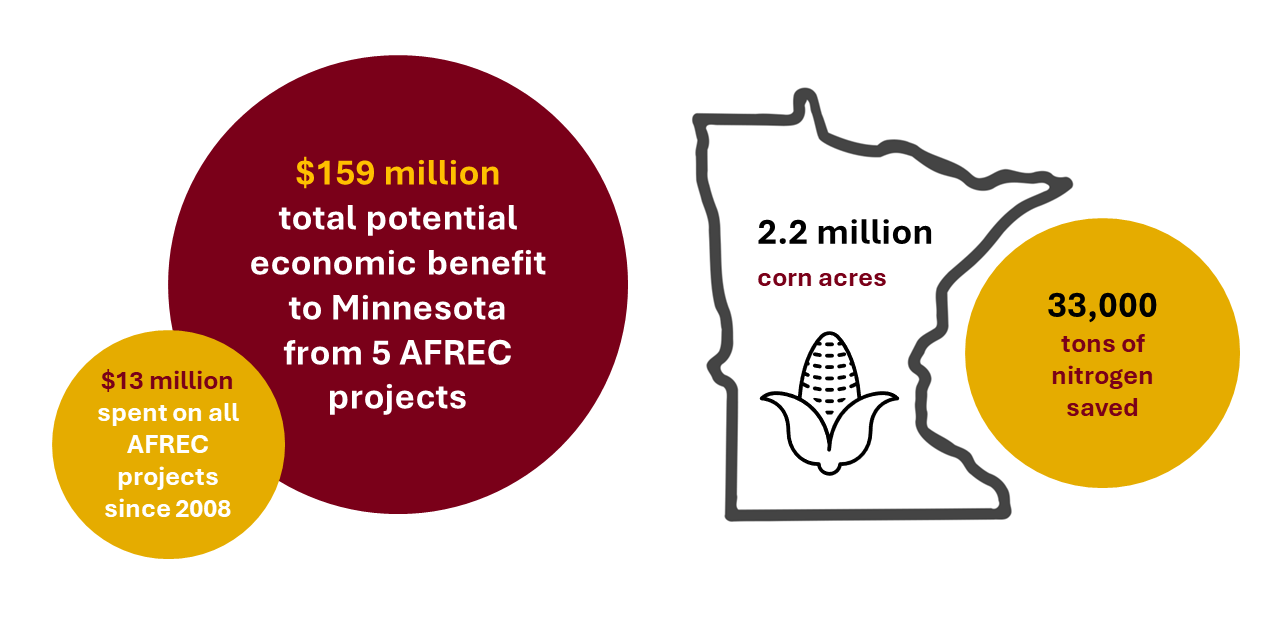Economic analysis of AFREC soil fertility research shows large potential benefit to Minnesota’s economy, environment

In 2023, Brigid Tuck, a Senior Economic Impact Analyst with University of Minnesota Extension, led an economic analysis of AFREC soil fertility research projects. The analysis looked at five of the over 200 projects that AFREC has funded since its inception in 2008. It found a total potential economic benefit to Minnesota of $159 million from the five AFREC projects.
Economic benefits ranged from $970,000 to $65 million per project and covered a variety of cropping systems, including corn, soybean, alfalfa, and sweet corn.
Tuck identified three scenarios where AFREC research has the potential to help Minnesota’s farmers and boost the state’s economy:
- Scenario #1 – Fertilizer use decreases, crop yield remains the same: Cutting input costs, without sacrificing yield, means higher profits for farmers. One of the projects in this scenario involved nitrogen fertilizer.
- Scenario #2 – Fertilizer use remains constant, crop yield increases: This scenario involves improvements in one of the 4Rs of nutrient stewardship other than fertilizer application rate. For example, by using the right fertilizer source or applying at the right time, farmers can increase yields without increasing how much fertilizer they use.
- Scenario #3 – Fertilizer use increases, crop yield increases: As long as the revenue generated from the increased yield exceeds the additional cost of the fertilizer, farmers can increase crop production and profits. The project in this scenario involved sulfur fertilizer.
Tuck used IMPLAN, an input-output modeling software, to see how putting more money in Minnesota farmers’ pockets impacts the state’s economy. IMPLAN is considered one of the best tools available to economists for economic impact analysis and is often referred to as a “spreadsheet of the economy.” The model determined that increasing farmer profits through improved soil fertility practices boosted economic activity across various economic sectors in Minnesota, from real estate and hospitals to stores and restaurants.
“The analysis clearly shows that farmers saving money on a good that is manufactured elsewhere, like fertilizer, and reinvesting those funds on the farm or to support their families has a positive economic benefit for Minnesota,” said Tuck.
The project also highlighted potential environmental benefits. For example, by using the University of Minnesota’s corn nitrogen rate calculator, supported by AFREC research, nitrogen fertilizer use could be reduced by 33,000 tons on 2.2 million corn acres while maintaining high crop yields. This would save farmers money while also improving Minnesota’s water quality.
This economic analysis demonstrates that investments in soil fertility research and education have the potential for significant economic benefit for Minnesota communities.
About Brigid Tuck
Brigid Tuck leads the Economic Impact Analysis program at University of Minnesota Extension. Since 2009, the program has issued more than three dozen studies, covering numerous economic sectors in Minnesota – including tourism, education, manufacturing, retail, infrastructure and local foods.

